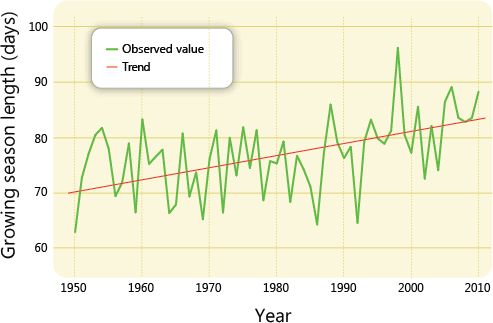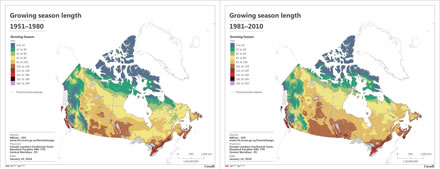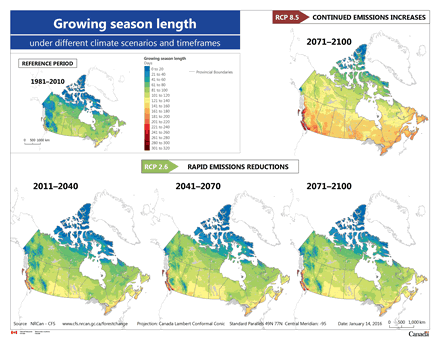Growing season is expected to increase across Canada, with implications for forest productivity and composition.
The length of the growing season is an important determinant of plant growth and distribution. Longer growing seasons may increase plant productivity and allow for new planting opportunities in agricultural and forestry settings. However, related changes in pest species, fire regimes, droughts, and other climate extremes may limit the extent to which these gains are realized.
There has been a significant increase in growing season length (approximately 2 days/decade) across the country over the 1950 to 2010 period. If CO2 emissions continue to increase, it is projected that growing seasons at the end of the 21st century will be 20 to 40 days longer than those currently experienced across much of Canada.
Why growing season is important
Growing season length has implications for both agricultural and forest productivity.
The length of the growing season indicates the amount of time that plants have to grow during a given year. It is an important determinant of plant growth and distribution. In principle, longer growing seasons could indicate increased productivity and new planting opportunities in agricultural and forest settings. However, climate change–related increases in risks associated with pests, droughts, fires and other climate extremes may limit the extent to which these gains are realized.
What has changed
Growing season length has increased across Canada over the period of 1950 to 2010.

Figure 1 – Past trends in growing season length for Canada (1950 to 2010)
Graph data - Figure 1
| Year | Growing season length (days) |
|---|---|
| 1950 | 62.82 |
| 1951 | 72.69 |
| 1952 | 77.06 |
| 1953 | 80.5 |
| 1954 | 81.81 |
| 1955 | 77.98 |
| 1956 | 69.38 |
| 1957 | 71.87 |
| 1958 | 78.99 |
| 1959 | 66.42 |
| 1960 | 83.37 |
| 1961 | 75.25 |
| 1962 | 76.57 |
| 1963 | 77.85 |
| 1964 | 66.3 |
| 1965 | 67.85 |
| 1966 | 80.81 |
| 1967 | 69.31 |
| 1968 | 73.71 |
| 1969 | 65.18 |
| 1970 | 76.18 |
| 1971 | 81.36 |
| 1972 | 66.39 |
| 1973 | 80.01 |
| 1974 | 73.14 |
| 1975 | 81.92 |
| 1976 | 74.5 |
| 1977 | 81.4 |
| 1978 | 68.62 |
| 1979 | 75.75 |
| 1980 | 75.34 |
| 1981 | 79.33 |
| 1982 | 68.31 |
| 1983 | 76.73 |
| 1984 | 74.23 |
| 1985 | 71.11 |
| 1986 | 64.21 |
| 1987 | 77.28 |
| 1988 | 86.05 |
| 1989 | 79.19 |
| 1990 | 76.31 |
| 1991 | 78.37 |
| 1992 | 64.49 |
| 1993 | 79.27 |
| 1994 | 83.31 |
| 1995 | 79.9 |
| 1996 | 78.92 |
| 1997 | 81.28 |
| 1998 | 96.37 |
| 1999 | 80.54 |
| 2000 | 77.28 |
| 2001 | 85.67 |
| 2002 | 72.56 |
| 2003 | 82.17 |
| 2004 | 74.1 |
| 2005 | 86.56 |
| 2006 | 89.24 |
| 2007 | 83.64 |
| 2008 | 82.88 |
| 2009 | 83.59 |
| 2010 | 88.38 |
Despite considerable annual variation, there was a significant increase in growing season length (1.7 days/decade) across the country over the 1950 to 2010 period (Figure 1). The pattern of change is relatively consistent across the country (Figure 2). Further analyses (not shown here) indicate that this change has been driven by both earlier start dates in the spring and later end dates in the fall.

Figure 2 – Growing season length for Canada for two time periods: 1951 to 1980 (left) and 1981 to 2010 (right)
Larger image [455 Kb]

Figure 3 – Reference period (1981 to 2010) and projected length of growing season for the short (2011 to 2040), medium (2041 to 2070), and long-term (2071 to 2100) under the Representative Concentration Pathway (RCP)Footnote * 2.6 (rapid emissions reductions) and, for the long-term (2071 to 2100), under RCP 8.5 (continued emissions increases) for Canada
Larger image [301 Kb]
The outlook
Growing season length is projected to increase as the century progresses.
Substantial increases in growing season length are projected by the end of the current century, with growing seasons 20 to 40 days longer than those currently experienced across much of the country (Figure 3).
How growing season and its indicators are defined
The growing season is the period during which the weather conditions are conducive to plant growth. The length of the growing season is limited by different factors, such as air temperature, frost days, rainfall, or daylight hours.
For this project, growing season length is calculated as the number of days between the last occurrence of 0°C in spring and the first occurrence of 0°C in fall. While each plant species has unique environmental cues to start and end its annual growth cycle, this growing season metric is a widely used general indicator of the timing of plant photosynthetic activity. Previously developed grids of daily minimum temperature for each day were used to get estimates over the 1950 to 2010 period across Canada (see research details). Future growing season length was estimated from a suite of 57 readily available predictor variables (e.g., monthly and annual temperature and precipitation variables) using a modern statistical technique called boosted regression trees (BRT) (see research details).
Sources and references for growing season and its indicators
- Brinkmann, W.A.R. 1979. Growing season length as an indicator of climatic variations. Climatic Change 2, 127-138.
- Christidis, N.N., Stott, P.A., et al. 2007. Human contribution to the lengthening of the growing season during 1950-99. Journal of Climate 20, 5441–5454.
- Hutchinson, M.F., McKenney, D.W., et al. 2009. Development and testing of Canada-wide interpolated spatial models of daily minimum-maximum temperature and precipitation for 1961–2003. Journal of Applied Meteorology and Climatology 48, 725–741.
- Intergovernmental Panel on Climate Change (IPCC). 2013. Climate change 2013: The physical science basis. Contribution of Working Group I to the Fifth Assessment Report of the Intergovernmental Panel on Climate Change. Cambridge, UK, and New York, NY: Cambridge University Press.
- McKenney, D.W., Hutchinson, M.F., et al. 2011. Customized spatial climate models for North America. Bulletin of the American Meteorological Society 92, 1611–1622.
- McKenney, D., Pedlar, J., et al. 2013. Spatial climate models for Canada’s forestry community. Forestry Chronicle 89, 659–663.
- Pedlar, J.H., McKenney, D.W., et al. 2015. A comparison of two approaches for generating spatial models of growing-season variables for Canada. Journal of Applied Meteorology and Climatology 54, 506–518.
- Quian, B., Gameda, S., et al. 2012. Changing growing season observed in Canada. Climatic Change 112, 339–353.
- Robeson, S.M. 2002. Increasing growing-season length in Illinois during the 20th century. Climatic Change 52, 219–238.
- Zhu, W.H., Thian, X., et al. 2012. Extension of the growing season due to delayed autumn over mid and high latitudes in North America during 1982–2006. Global Ecology and Biogeography 21, 260–271.
Canadian Forest Service key contacts
- John H. Pedlar, Forest Landscape Biologist, Great Lakes Forestry Centre
- Daniel W. McKenney, Chief, Landscape Analysis and Applications, Great Lakes Forestry Centre
- David Price, Research Scientist, Integrative Climate Change Impacts Modelling, Northern Forestry Centre
Adaptation tools and resources
Forest Change Toolkit – a list of tools and resources for climate change adaptation
- A comparison of two approaches for generating spatial models of growing-season variables for Canada (2015)
- Customized spatial climate models for North America (2011)
- Development and testing of Canada-wide interpolated spatial models of daily minimum-maximum temperature and precipitation for 1961–2003 (2009)
- Effect of plant age and length of growing season on the development of blister rust cankers in western white pine (2005)
- Interannual and spatial impacts of phenological transitions, growing season length, and spring and autumn temperatures on carbon sequestration: a North America flux data synthesis (2012)
- Spatial climate models for Canada’s forestry community (2013)